Spatial Localization of Transformer Inspection Robot Based on Adaptive Denoising and SCOT-β Generalized Cross-Correlation
Abstract
:1. Introduction
2. Ultrasonic Positional Localization Strategies for Transformer Internal Inspection Robots
2.1. Ultrasound Signal Denoising Based on Improved EMD Method
- The number of over-zero points of the IMF component should be the same as or differ only by one from the number of extreme points;
- The upper and lower envelopes have an average value of 0 at any point in the entire signal.
- Find all the extreme points of the signal x(t) (endpoints are processed by mirroring);
- The envelope of the upper and lower extreme points emax(t) and emin(t) are fitted with three time spline curves, and the mean value of the upper and lower envelopes m(t) is found. h(t) can be expressed as h(t) = x(t) − m(t); the mean value is expressed as follows:
- 3.
- Determine whether h(t) is an IMF based on a predefined criterion;
- 4.
- If not, replace x(t) with h(t) and repeat the above steps until h(t) satisfies the criterion, then h(t) is the IMFi(t) that needs to be extracted;
- 5.
- For each order of IMF obtained, subtract it from the original signal. Repeat the above steps until the last remaining part of the signal rn is a monotonic sequence or a constant value sequence.
- The sum of the bandwidths of the center frequencies of each modal component is required to be a minimum;
- The sum of all modal components is equal to the original signal.
- The number of modes to be obtained can be specified;
- The decomposed IMFs all have independent center frequencies and exhibit sparsity characteristics in the frequency domain, possessing the qualities of sparse study;
- In the process of solving the IMF, the endpoint effect that occurs in the ordinary EMD decomposition is avoided by way of mirror extension;
- Effective avoidance of modal aliasing, with appropriate selection of K values.
2.2. Ultrasonic Positional Localization Method Based on an Improved Generalized Mutual Correlation Algorithm
2.3. Three-Dimensional Spatial Positional Localization Algorithms for Transformer Internal Inspection Robots
3. Ultrasonic Spatial Positional Localization Simulation Test for Inspection Robots
3.1. Simulation Verification of Improved Adaptive Denoising Algorithm
3.2. Simulation Validation of Improved Generalized Cross-Correlation Delay Estimation Methods
4. Ultrasonic Spatial Positional Localization Practical Test for Inspection Robots
4.1. Test Platform for Three-Dimensional Spatial Positional Localization
4.2. Data Acquisition
4.3. Analysis of Positioning Test Results
5. Conclusions
Author Contributions
Funding
Institutional Review Board Statement
Informed Consent Statement
Data Availability Statement
Conflicts of Interest
References
- Xu, Y.; Liu, W.; Gao, W.; Zhang, X.; Wang, Y. Comparison of PD detection methods for power transformers-their sensitivity and characteristics in time and frequency domain. IEEE Trans. Dielectr. Electr. Insul. 2016, 23, 2925–2932. [Google Scholar] [CrossRef]
- Wu, Z.; Zhou, L.; Lin, T.; Zhou, X.; Wang, D.; Gao, S.; Jiang, F. A new testing method for the diagnosis of winding faults in transformer. IEEE Trans. Instrum. Meas. 2020, 69, 9203–9214. [Google Scholar] [CrossRef]
- Wang, Y.B.; Chang, D.G.; Fan, Y.H.; Zhang, G.J.; Zhan, J.Y.; Shao, X.J.; He, H.L. Acoustic localization of partial discharge sources in power transformers using a particle-swarm-optimization-route-searching algorithm. IEEE Trans. Dielectr. Electr. Insul. 2017, 24, 3647–3656. [Google Scholar] [CrossRef]
- Jiang, R.; Zhang, L.; Yang, J.; Zheng, C.; Duan, X.; Xue, J.; Li, W.; Chan, Q.; Guo, T. Fault Diagnosis and Treatment of a Newly Put into Operation 220kV Transformer. In Proceedings of the 2022 China International Conference on Electricity Distribution (CICED 2022), Changsha, China, 7–8 September 2022; pp. 1001–1006. [Google Scholar]
- Cheng, J.; Wang, S.; Huang, K.; Bao, L.; La, Y.; Guo, T. Analysis of discharge phenomenon in an UHV converter transformer during factory test. In Proceedings of the 16th IET International Conference on AC and DC Power Transmission (ACDC 2020), Online Conference, 2–3 July 2020; pp. 2231–2234. [Google Scholar]
- Ackerman, E. The underwater transformer: Ex-NASA engineers built a robot sub that transforms into a skilled humanoid. IEEE Spectr. 2019, 56, 22–29. [Google Scholar] [CrossRef]
- Yue, C.; Guo, S.; Li, M.; Li, Y.; Hirata, H.; Ishihara, H. Mechatronic system and experiments of a spherical underwater robot: SUR-II. J. Intell. Robot. Syst. 2015, 80, 325–340. [Google Scholar] [CrossRef]
- Ji, H.; Cui, X.; Ren, W.; Liu, L.; Wang, W. Visual inspection for transformer insulation defects by a patrol robot fish based on deep learning. IET Sci. Meas. Technol. 2021, 15, 606–618. [Google Scholar] [CrossRef]
- Ji, H.; Liu, X.; Zhang, J.; Liu, L. Spatial Localization of a Transformer Robot Based on Ultrasonic Signal Wavelet Decomposition and PHAT-β-γ Generalized Cross Correlation. Sensors 2024, 24, 1440. [Google Scholar] [CrossRef] [PubMed]
- Huang, Z.; Zhu, J.; Yang, L.; Xue, B.; Wu, J.; Zhao, Z. Accurate 3-D position and orientation method for indoor mobile robot navigation based on photoelectric scanning. IEEE Trans. Instrum. Meas. 2015, 64, 2518–2529. [Google Scholar] [CrossRef]
- Ko, M.H.; Ryuh, B.S.; Kim, K.C.; Suprem, A.; Mahalik, N.P. Autonomous greenhouse mobile robot driving strategies from system integration perspective: Review and application. IEEE/ASME Trans. Mechatron. 2014, 20, 1705–1716. [Google Scholar] [CrossRef]
- Chae, H.W.; Choi, J.H.; Song, J.B. Robust and autonomous stereo visual-inertial navigation for non-holonomic mobile robots. IEEE Trans. Veh. Technol. 2020, 69, 9613–9623. [Google Scholar] [CrossRef]
- Ji, H.; Cui, X.; Gao, Y.; Ge, X. 3-D ultrasonic localization of transformer patrol robot based on EMD and PHAT-β algorithms. IEEE Trans. Instrum. Meas. 2021, 70, 1–10. [Google Scholar] [CrossRef]
- Gao, Y.; Liu, Y.; Ma, Y.; Chang, X.; Yang, J. Application of the differentiation process into the correlation-based leak detection in urban pipeline networks. Mech. Syst. Signal Process. 2018, 112, 251–264. [Google Scholar] [CrossRef]
- Ollivier, B.; Pepperell, A.; Halstead, Z.; Hioka, Y. Noise robust bird call localisation using the generalised cross-correlation with phase transform in the wavelet domain. J. Acoust. Soc. Am. 2019, 146, 4650–4663. [Google Scholar] [CrossRef] [PubMed]
- Fereidoony, F.; Jishi, A.; Hedayati, M.; Wang, Y.E. Magnitude-delay least mean squares equalization for accurate estimation of time of arrival. IEEE Sens.J. 2021, 21, 18075–18084. [Google Scholar] [CrossRef]
- Youn, D.; Ahmed, N.; Carter, G. On using the LMS algorithm for time delay estimation. IEEE Trans. Acoust. Speech Signal Process. 1982, 30, 798–801. [Google Scholar] [CrossRef]
- Zheng, Q.; Luo, L.; Song, H.; Sheng, G.; Jiang, X. A RSSI-AOA-based UHF partial discharge localization method using MUSIC algorithm. IEEE Trans. Instrum. Meas. 2021, 70, 1–9. [Google Scholar] [CrossRef]
- Cremer, M.; Dettmar, U.; Hudasch, C.; Kronberger, R.; Lerche, R.; Pervez, A. Localization of Passive UHF RFID Tags Using the AoAct Transmitter Beamforming Technique. IEEE Sens. J. 2016, 16, 1762–1771. [Google Scholar] [CrossRef]
- Guo, L.; Deng, H.; Himed, B.; Ma, T.; Geng, Z. Waveform Optimization for Transmit Beamforming with MIMO Radar Antenna Arrays. IEEE Trans. Antennas Propag. 2015, 63, 543–552. [Google Scholar] [CrossRef]
- Dragomiretskiy, K.; Zosso, D. Variational Mode Decomposition. IEEE Trans. Signal Process. 2014, 62, 531–544. [Google Scholar] [CrossRef]
- Yanovsky, I.; Dragomiretskiy, K. Variational Destriping in Remote Sensing Imagery: Total Variation with L1 Fidelity. Remote Sens. 2018, 10, 300. [Google Scholar] [CrossRef]
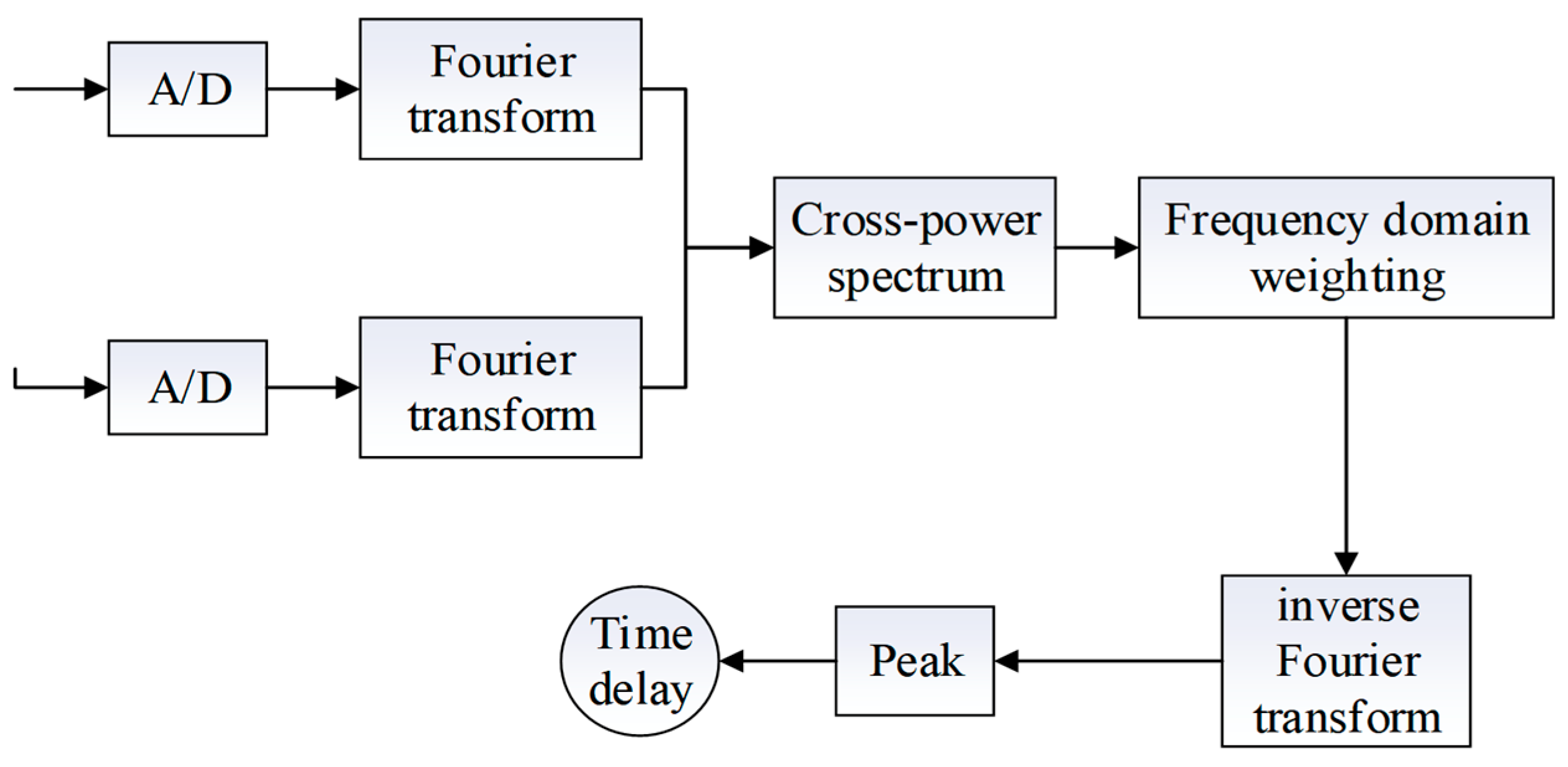

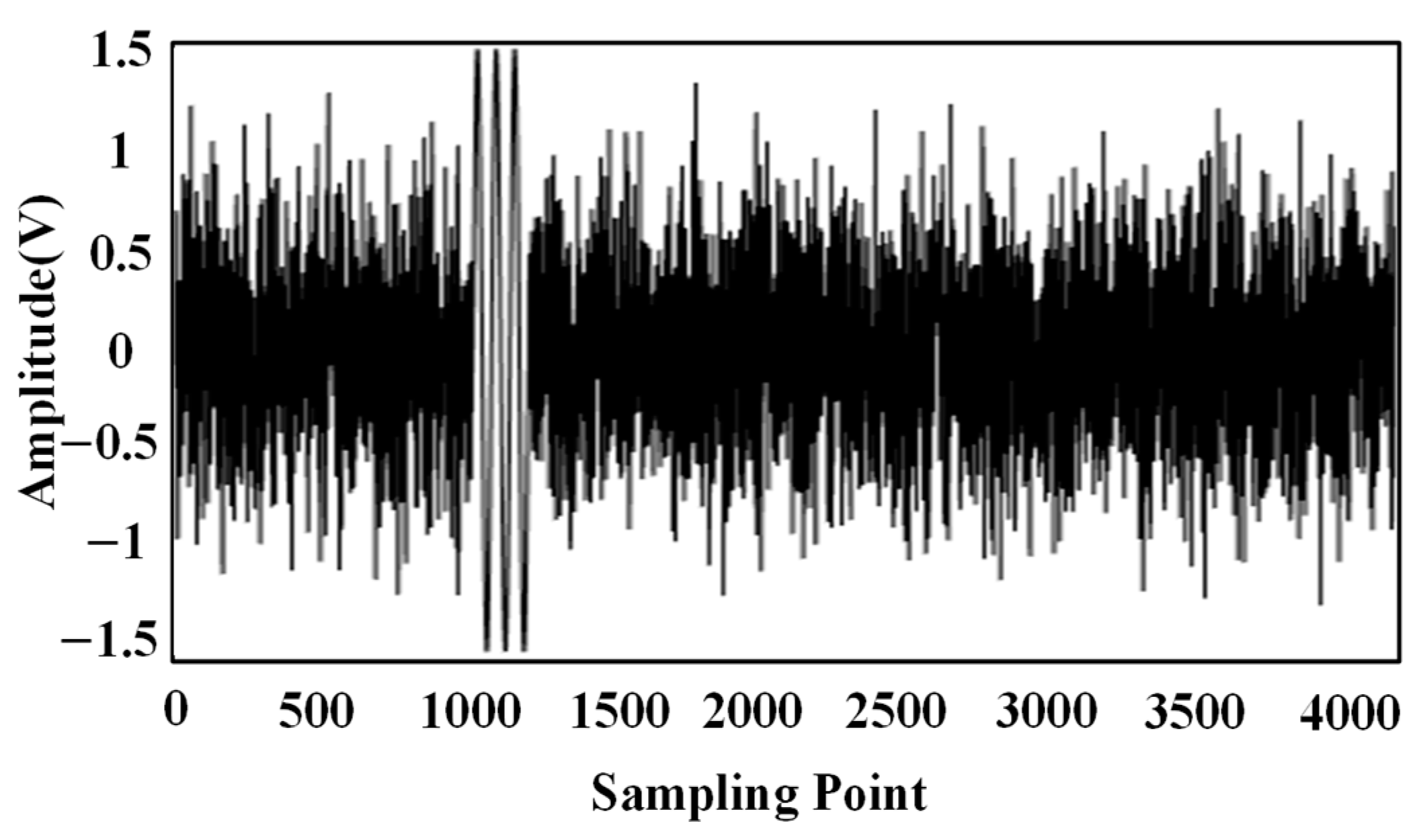
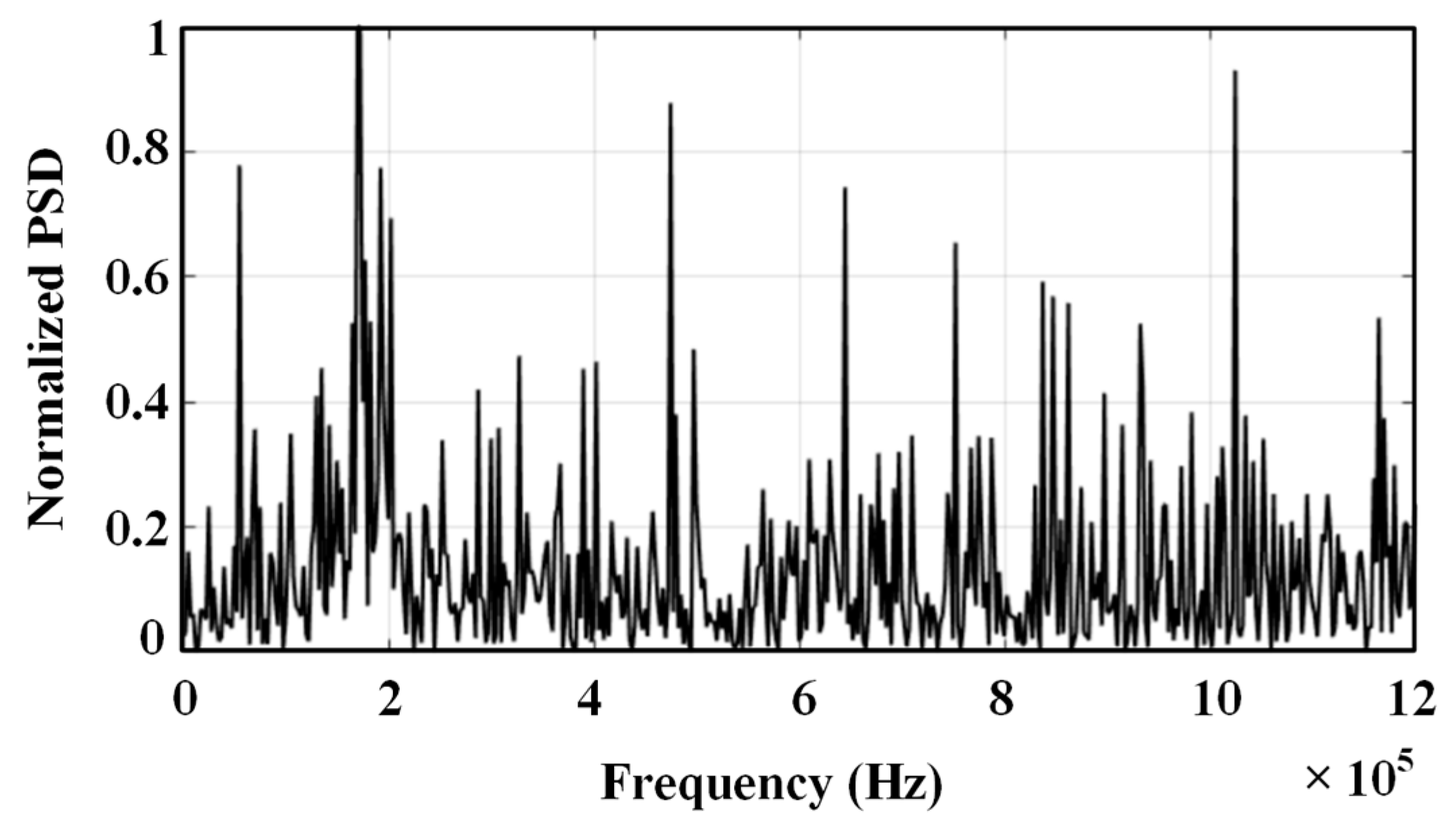
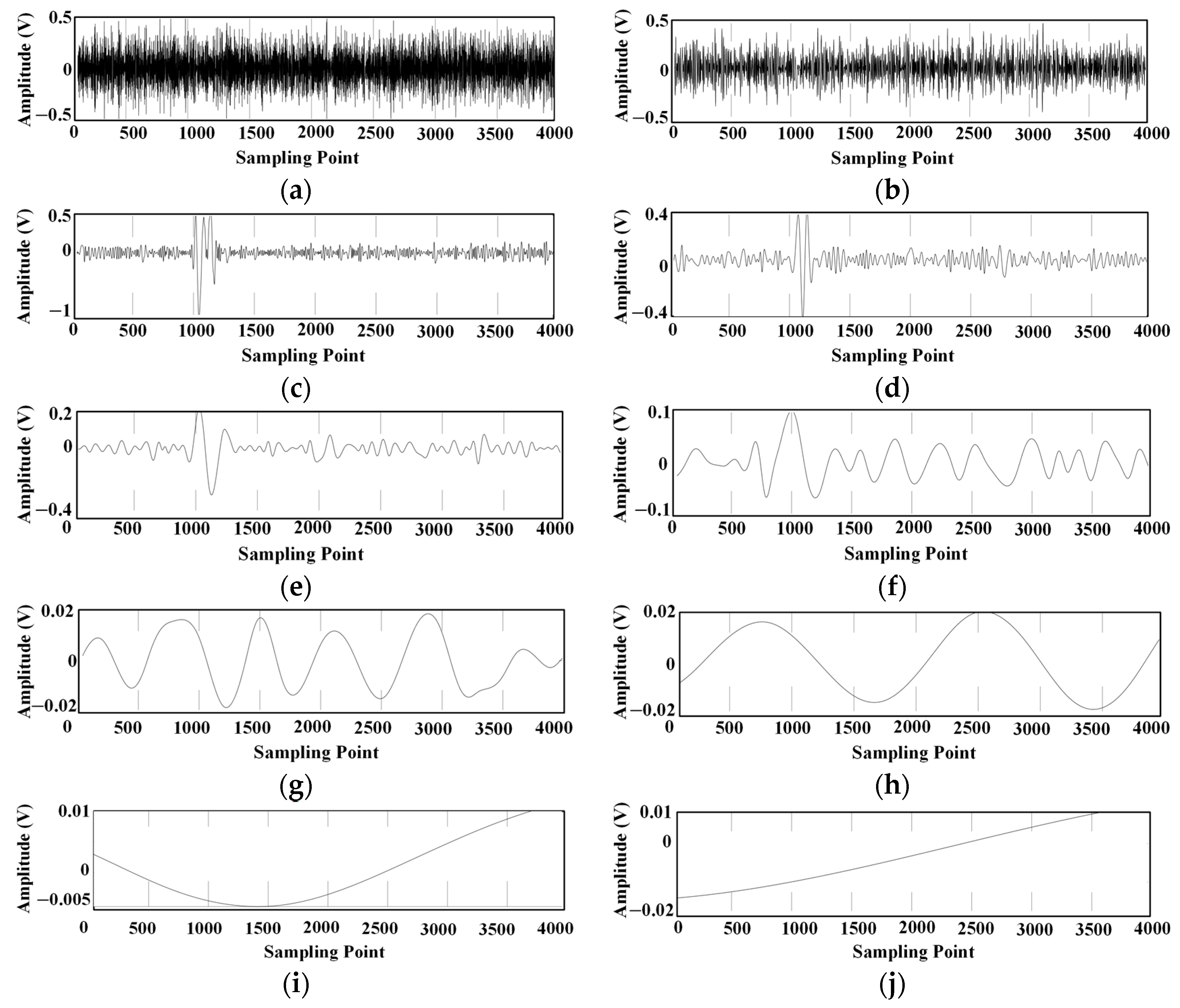




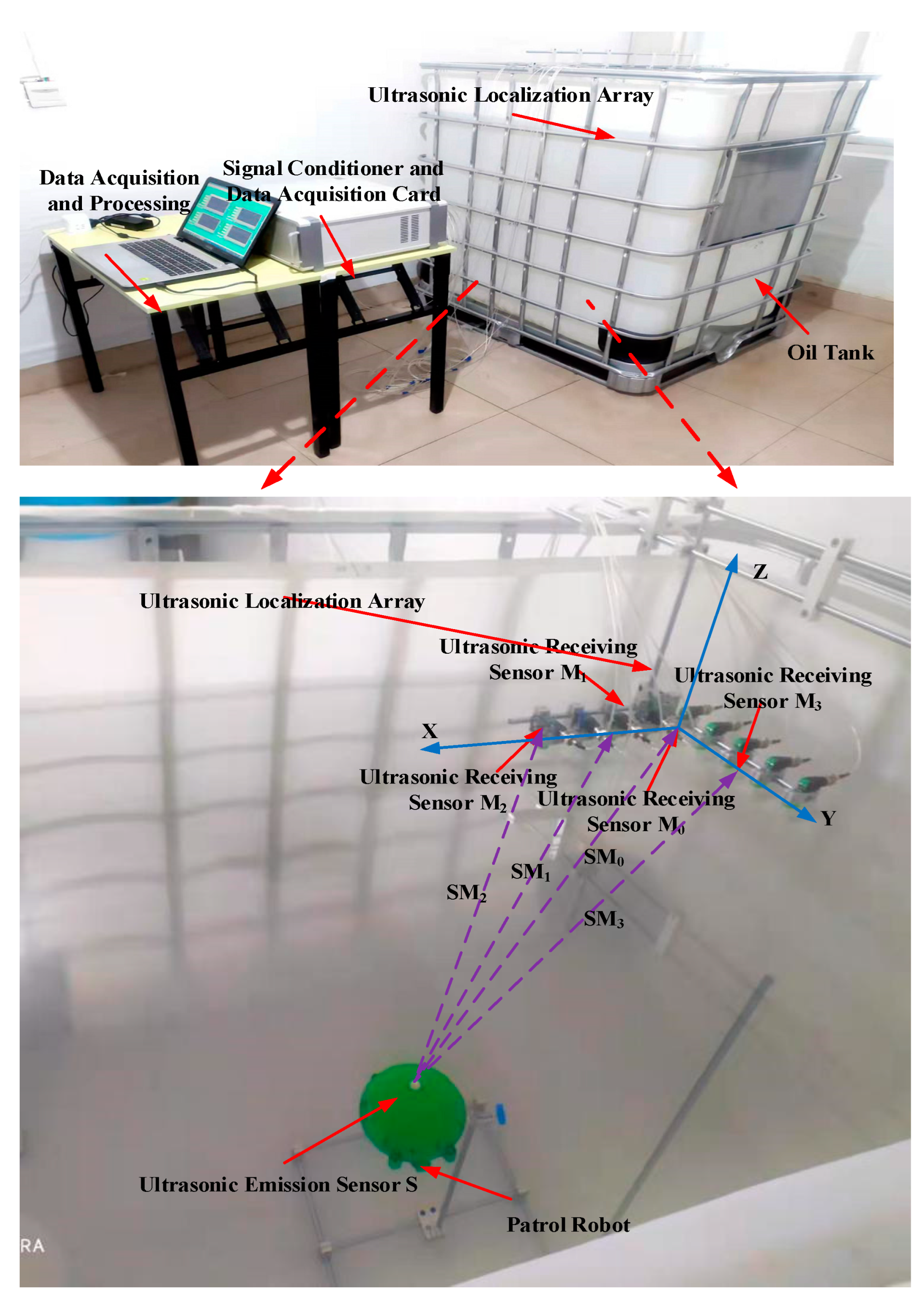
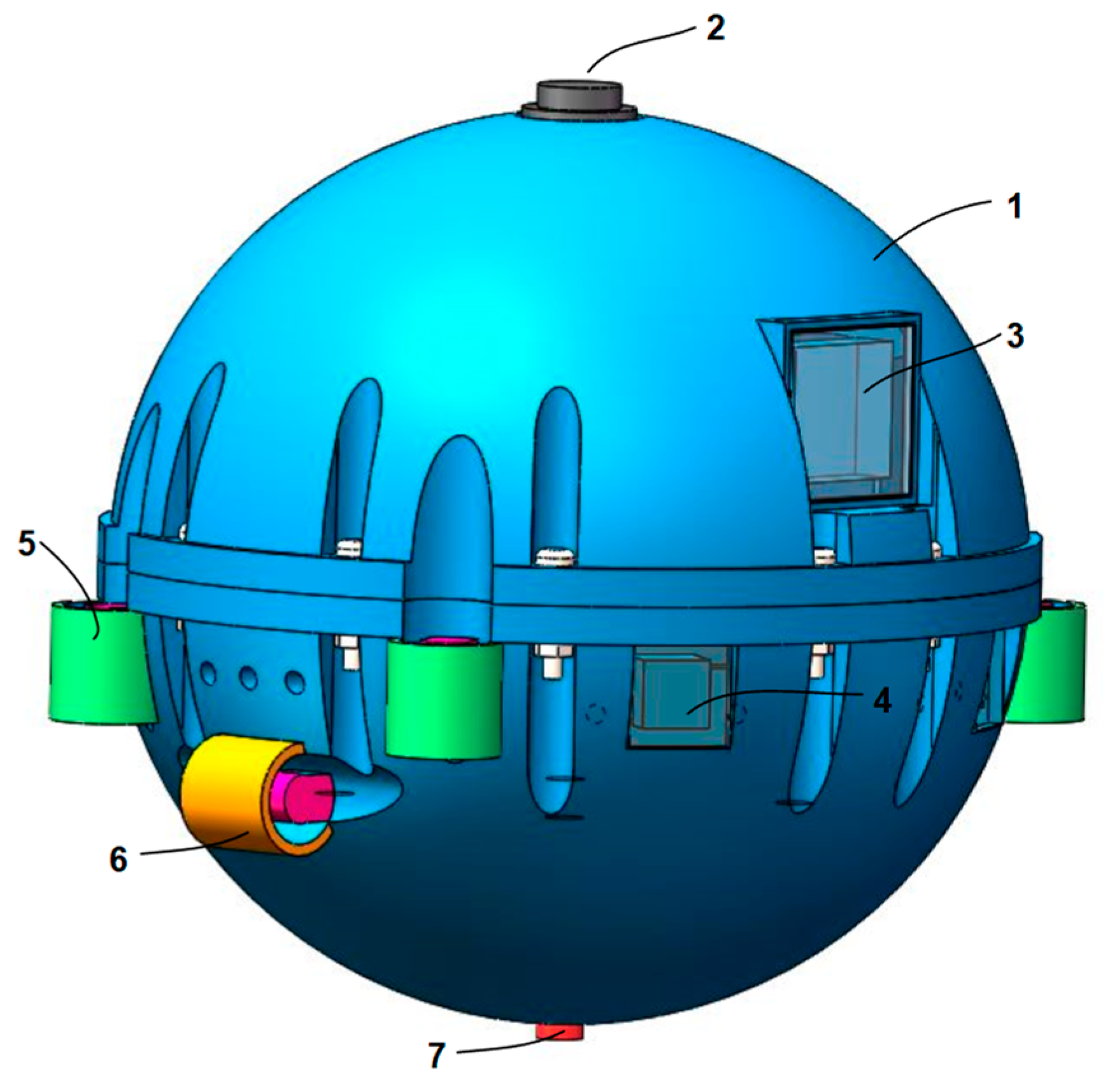

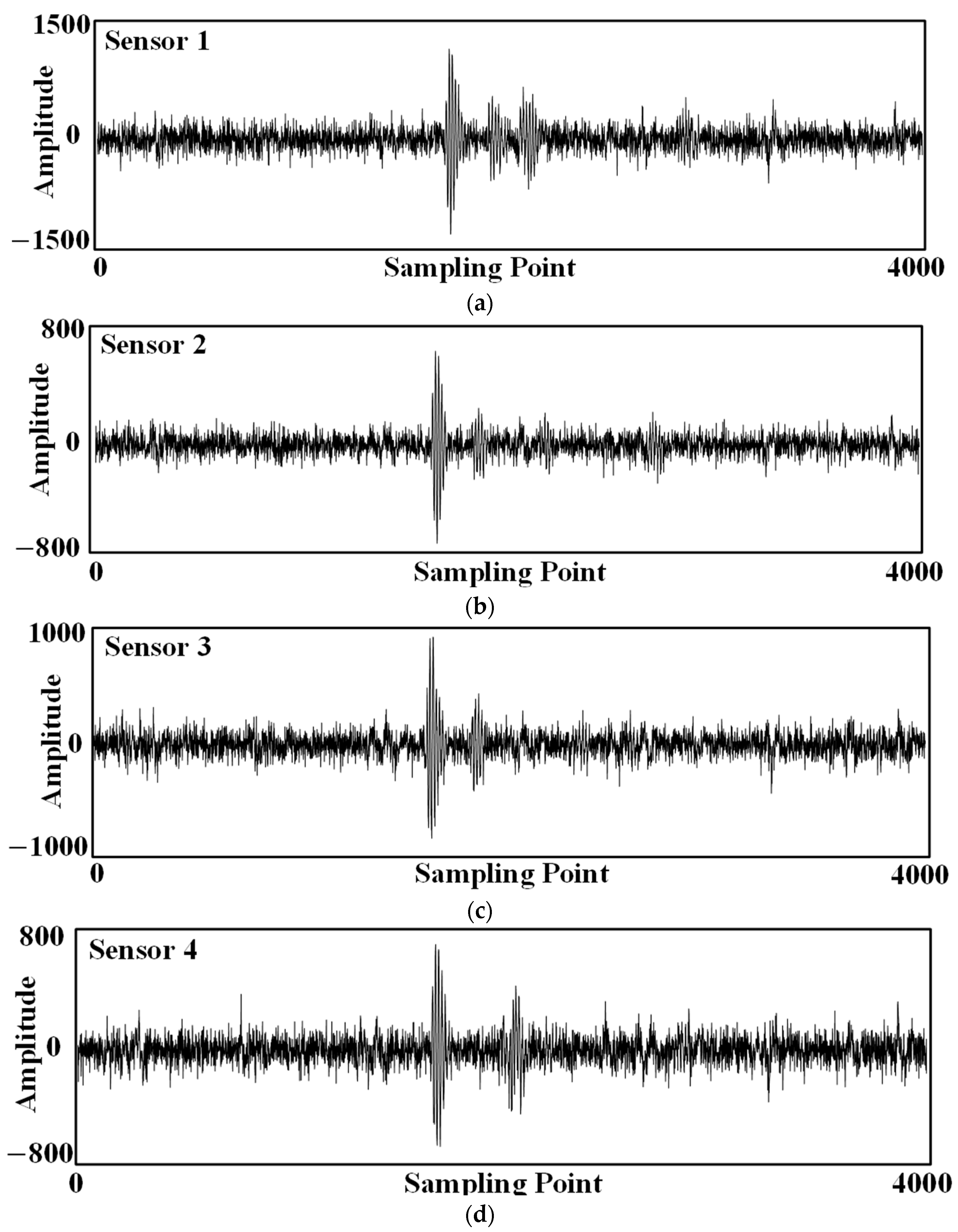
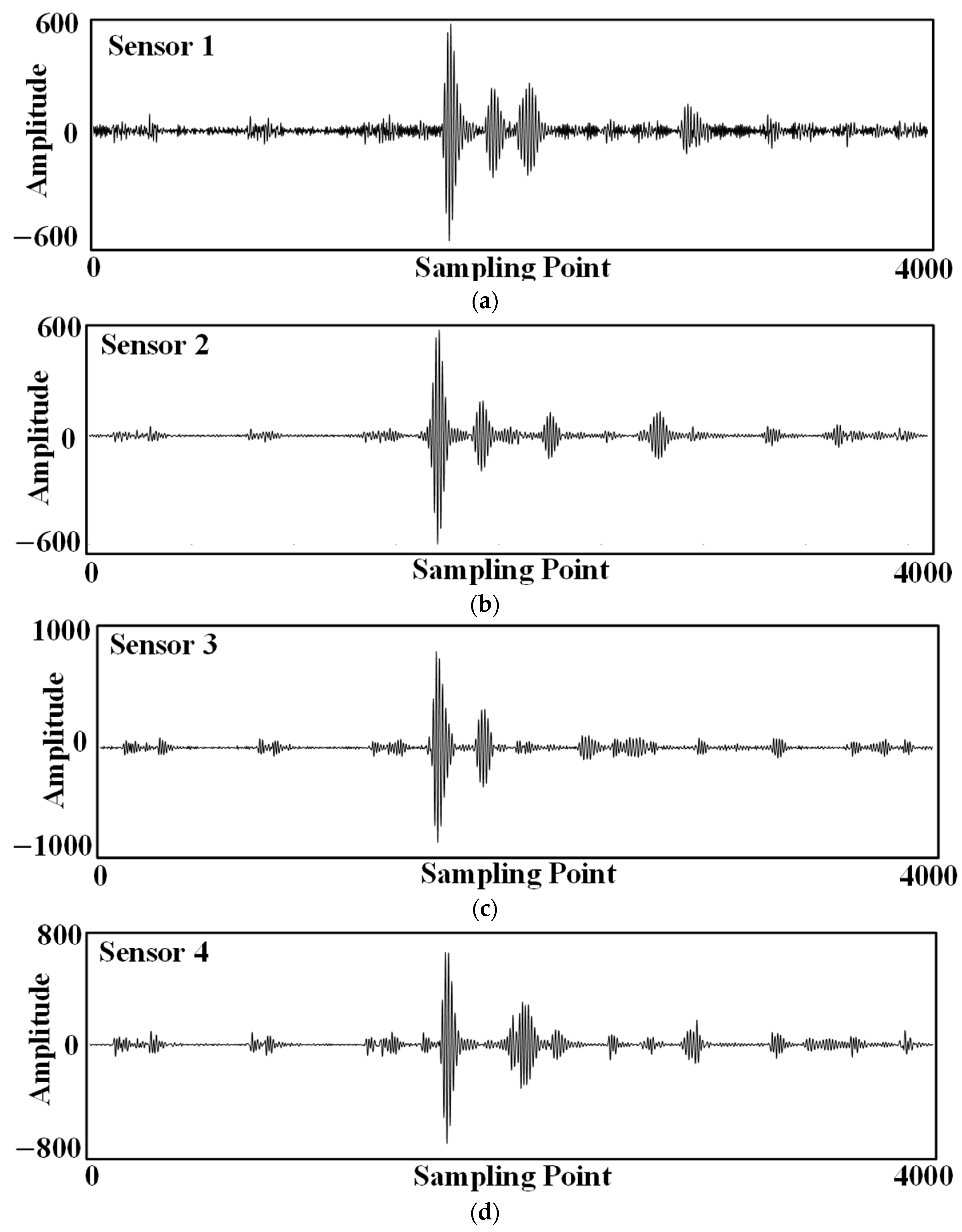
| Medium | Speed m/s |
|---|---|
| hydrogen | 1280 |
| air | 330 |
| SF6 | 140 |
| mineral oil | 1400 |
| water | 1480 |
| porcelain | 5600–6200 |
| Oil-paper | 1420 |
| steel | 6000 |
| copper | 4700 |
| epoxy resin | 2400–2900 |
| polyethylene | 2000 |
| Denoising Method | SNR/dB | RMSE | NCC |
|---|---|---|---|
| Traditional EMD | 4.2763 | 0.1009 | 0.8137 |
| Improved EMD | 6.5891 | 0.0708 | 0.8966 |
| Bandpass filtering | 4.0836 | 0.0945 | 0.7874 |
| Num | Delay20 (μs) | Delay10 (μs) | Delay30 (μs) |
|---|---|---|---|
| 1 | 38.4 | 23.6 | 10.0 |
| 2 | 38.4 | 23.6 | 10.0 |
| 3 | 38.4 | 23.6 | 10.0 |
| 4 | 38.8 | 23.6 | 10.0 |
| 5 | 38.8 | 24.0 | 10.0 |
| 6 | 38.8 | 23.6 | 9.6 |
| 7 | 38.4 | 23.6 | 10.0 |
| 8 | 38.8 | 23.6 | 9.6 |
| 9 | 38.4 | 24.0 | 9.6 |
| 10 | 38.8 | 23.6 | 10.0 |
| 11 | 38.4 | 23.6 | 10.0 |
| 12 | 38.8 | 24.0 | 9.6 |
| 13 | 38.4 | 23.6 | 9.6 |
| 14 | 38.8 | 24.0 | 10.4 |
| 15 | 38.8 | 23.6 | 10.4 |
| 16 | 38.4 | 23.6 | 9.6 |
| 17 | 38.8 | 24.0 | 9.6 |
| 18 | 38.8 | 24.0 | 9.6 |
| 19 | 38.8 | 23.2 | 10.4 |
| 20 | 38.4 | 23.6 | 10.0 |
| Num | Delay20 (μs) | Delay10 (μs) | Delay30 (μs) | Position Coordinate/cm |
|---|---|---|---|---|
| 1 | 38.8 | 23.6 | 10.0 | 31, 18, −71 |
| 2 | 38.8 | 24.0 | 9.6 | 30, 20, −70 |
| 3 | 38.4 | 23.6 | 9.6 | 31, 18, −70 |
| 4 | 38.4 | 24.0 | 9.6 | 31, 20, −70 |
| 5 | 38.8 | 24.0 | 10.0 | 31, 19, −71 |
| 6 | 38.8 | 23.6 | 9.6 | 30, 20, −71 |
| 7 | 38.4 | 23.6 | 10.0 | 31, 18, −71 |
| 8 | 38.8 | 23.2 | 10.4 | 32, 20, −73 |
| 9 | 38.8 | 24.0 | 10.4 | 31, 20, −71 |
| 10 | 38.8 | 23.6 | 10.4 | 32, 19, −72 |
Disclaimer/Publisher’s Note: The statements, opinions and data contained in all publications are solely those of the individual author(s) and contributor(s) and not of MDPI and/or the editor(s). MDPI and/or the editor(s) disclaim responsibility for any injury to people or property resulting from any ideas, methods, instructions or products referred to in the content. |
© 2024 by the authors. Licensee MDPI, Basel, Switzerland. This article is an open access article distributed under the terms and conditions of the Creative Commons Attribution (CC BY) license (https://creativecommons.org/licenses/by/4.0/).
Share and Cite
Ji, H.; Zheng, C.; Tang, Z.; Liu, X.; Liu, L. Spatial Localization of Transformer Inspection Robot Based on Adaptive Denoising and SCOT-β Generalized Cross-Correlation. Sensors 2024, 24, 4937. https://doi.org/10.3390/s24154937
Ji H, Zheng C, Tang Z, Liu X, Liu L. Spatial Localization of Transformer Inspection Robot Based on Adaptive Denoising and SCOT-β Generalized Cross-Correlation. Sensors. 2024; 24(15):4937. https://doi.org/10.3390/s24154937
Chicago/Turabian StyleJi, Hongxin, Chao Zheng, Zijian Tang, Xinghua Liu, and Liqing Liu. 2024. "Spatial Localization of Transformer Inspection Robot Based on Adaptive Denoising and SCOT-β Generalized Cross-Correlation" Sensors 24, no. 15: 4937. https://doi.org/10.3390/s24154937





